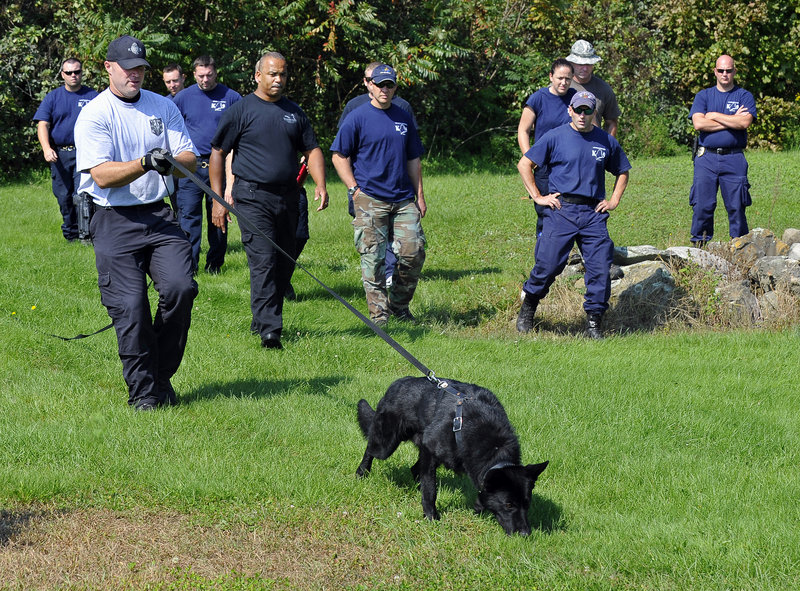SCARBOROUGH — Taz, a German shepherd that serves with Portland police, led Officer Christian Stickney through a large field behind Beech Ridge Farm.
Like a good tracker, Taz kept his nose close to the invisible trail and the distinctive smell given off by a trainer who had walked that way a short time before.
The dog’s ability to stay on that scent, disregarding all others that criss-crossed the track, earned him slices of hot dog that had been left in the grass along the way. That training – repeated countless times – will improve the dog’s chances of tracking a holdup suspect through the streets of Portland, even if the person is covering ground that 100 people have walked on that day.
“The dog is looking for the freshest scent,” said Stickney. “If you’ve just done something like a robbery, you’ve got that adrenaline. We call it fear scent. You’re putting a lot more out there and the dog gives us a different read.”
Police dogs have been called on frequently of late as officers have tried to track down pharmacy robbers, car burglars and murder suspects. Monday night, Taz was at work searching, unsuccessfully as it turned out, for a man who robbed a pharmacy on Brighton Avenue.
The track doesn’t always end with a suspect. In fact, particularly in the city, it often leads to where a person got into a car.
But police say even that can be important information, helping them search for potential witnesses who might have seen the getaway car. Just as officers dust for fingerprints or search for biological evidence that might contain DNA, using a dog is a technique that can pay big dividends, said Lt. Gary Rogers, head of detectives for Portland police.
After a fatal shooting in August at an apartment building at Congress Street and Massachusetts Avenue, Taz was put to work tracking the suspect’s scent. He led his handler to a clump of bushes off Massachusetts Avenue, where Stickney discovered a gun that police believe was used in the shooting.
“We may not have found the gun without a dog. It was several doors down and in the bushes,” Rogers said.
Each one of us leaves a distinct “footprint” that a dog can follow. It’s not necessarily an impression in the ground, but a unique collection of odors drawn from skin cells, sweat, soap and even the distinctive leather and oils in a pair of boots.
Troy Caisey, lead trainer for the 200 canine teams maintained by the Boston Police Department, is spending three days working with a group of canine teams from southern Maine on how best to track that footprint.
They are working on the finer points of tracking, such as following someone footstep-by-footstep or by trailing, in which a dog has a wider search pattern and hits on pools of odor that collect alongside a building or in a depression.
They start in fields like the one at Beech Ridge Farm, then move to industrial parks, where dogs can work through the conflicting scents and the lack of easy tracking topography.
“It gets us as close to real-world training as we can,” Caisey said. “It’s extremely difficult (tracking) in the city, but it can be done if you have a disciplined handler and disciplined dog.”
The dogs train to avoid all other smells that criss-cross the one they’re tracking.
“Once a dog gets locked on a scent, he can go through a lot of scents and keep on going,” said David Thompson of the Westbrook police, whose dog Maria recently helped find two car burglars hiding under a porch.
The dogs depend on their remarkable sense of smell. Humans have five to six million olfactory receptors; dogs have about 220 million.
Police dogs aren’t ordinary canines. They are bred for their sense of smell and ability to learn. Those that make the grade are elevated to working dog status – the professional athletes of the canine world, Stickney said.
This week’s training focuses on tracking, but the police dogs have other skills. They can search for items, sniff for drugs and take down a suspect. Although bloodhounds have superior tracking abilities, they are not appropriate for pursuing a violent suspect in a building.
The canine programs are typically supported with donations from the public. A police dog can cost from $6,200, for a dog that shows aptitude but has to be trained, to $15,000 if fully trained.
The work isn’t always in pursuit of criminals.
Last summer, Taz found an 81-year-old Alzheimer’s patient who had wandered away from a doctor’s office on Sewall Street. She was found in woods off the Fore River Parkway.
“I definitely feel confident we, as a team, saved that woman’s life,” Stickney said.
Staff Writer David Hench can be contacted at 791-6327 or at: dhench@pressherald.com
Copy the Story Link
Send questions/comments to the editors.




Success. Please wait for the page to reload. If the page does not reload within 5 seconds, please refresh the page.
Enter your email and password to access comments.
Hi, to comment on stories you must . This profile is in addition to your subscription and website login.
Already have a commenting profile? .
Invalid username/password.
Please check your email to confirm and complete your registration.
Only subscribers are eligible to post comments. Please subscribe or login first for digital access. Here’s why.
Use the form below to reset your password. When you've submitted your account email, we will send an email with a reset code.